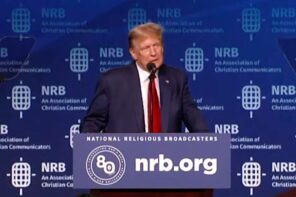On Wednesday, February 25, the Supreme Court decided Pleasant Grove City, Utah v. Summum, an easy and insignificant free speech case. Unfortunately, the Court sidestepped the profound Establishment Clause issues within the case, leaving America mired in culture war confusion about the proper relationship of church and state.
Summum, founded in 1975 and headquartered in Salt Lake City, is dedicated to a form of Gnostic Christianity. According to its beliefs, the original tablets given by God to Moses did not contain the Ten Commandments, but instead consisted of what they call the “Seven Aphorisms.” Moses did not believe the Children of Israel were ready for the wisdom of these teachings, so he shared them with only a select group of people. Moses then destroyed the original tablets, returned to Mount Sinai, and received a second set of tablets that contained the Ten Commandments.
A Curious Argument
In 2003 Summum requested permission to erect a monument in a public park that already contained other monuments, including Pleasant Grove’s first fire station, a September 11 commemoration, and a display of the Ten Commandments donated to the city by the Fraternal Order of Eagles in 1971. Summum stated that its “Seven Aphorisms” display would be similar in size and nature to the Ten Commandments monument already in the park.
The city denied Summum’s request, explaining that its practice was to limit monuments to those relating to the history of Pleasant Grove or those donated by groups with longstanding ties to the local community. This policy had never been put in written form but was later adopted by formal city resolution.
In 2005, Summum renewed it request and, when the city failed to respond, sued the city in federal court. Summum argued that its free speech rights had been violated by the city’s refusal to treat its proposal the same way it had treated the Ten Commandments monument donated by the Eagles. Summum did not argue, however, that the city had violated the Establishment Clause by preferring the biblical account of the events of Mount Sinai over its account. In fact, for purposes of its free speech challenge, Summum treated the Ten Commandments display as having nothing really to do with the city. That monument, said Summum, represented the private message of the Eagles. Since the city allowed another private group to proclaim its message in the park, it should allow Summum to do the same by allowing it to erect its own monument.
The District Judge denied relief to Summum, but the Tenth Circuit Court of Appeals reversed, ruling that the city must allow Summum’s proposed monument and holding that public parks are public forums traditionally open to private expression; the city’s standards, limiting monuments to those historically relevant to the community, discriminated among allowable private messages. Just as the city obviously could not restrict the park to only political demonstrations with historically relevant messages, it could not do so in the case of privately donated monuments either.
Pleasant Grove City never denied that it was discriminating against Summum’s message on the basis of history, nor that it would not be allowed to do that if Summum wanted to stage a rally in the park instead of putting up a monument. The city argued that the Ten Commandments display—and all the other donated monuments—no longer represented the speech of the groups that had donated them. Once the city accepted and displayed a monument it became the speech of the city, not that of the private group.
For the Prevention of Cluttered and Weird Parks
The doctrine of government speech is of relatively recent vintage, but the principle is not controversial. When the government is regulating the messages of private persons or groups, it must normally be strictly neutral about the subject matter of the speech involved. It is no business of the government, for example, whether a parade permit allows a march in celebration of St. Patrick’s Day or in protest of the war in Iraq. But when the government is speaking on its own behalf—as in spending taxpayer money to argue in favor of the war in Iraq—then the government not only may, but in practice inevitably must, make just such discriminations in the content and viewpoint it endorses. Normally, the government is free to say on its own behalf anything it likes.
Pleasant Grove appealed the ruling of the Court of Appeals to the United States Supreme Court and the Supreme Court reversed, agreeing with the city that the Ten Commandments display and other monuments represented the speech of the city. Therefore, the city was permitted to make the sorts of distinctions among monuments that it had made here. There was no dissent in the case, although Justice Souter only concurred in the Court’s judgment.
There was a good reason for the Justices’ essential unanimity. If the Court of Appeals’ ruling had remained intact, it is hard to see how permanent public park displays would be manageable. In a public park near my house in Pittsburgh, the city has erected monuments in honor of the Spanish-American and Civil Wars. If Summum’s position had prevailed, private groups could request permission to erect all sorts of historic markers and Pittsburgh would be prohibited from making any substantive judgments in choosing among them, such as historic significance or aesthetic value. My local park could become both cluttered and weird. This is why Pleasant Grove City was easy to decide on free speech grounds.
But, as Justice Scalia wrote in a concurrence, this free speech case was “litigated in the shadow” of the Establishment Clause. In general, government is permitted to say anything it likes. But one limit on the doctrine of government speech is that the government may not prefer one religion over another. Pleasant Grove City is not permitted to put up a display of the Ten Commandments while refusing to accept the Seven Aphorisms if its reason for doing so is that the Ten Commandments are true and the Seven Aphorisms are not.
The underlying uneasiness about the case is that the city might well have been making exactly this judgment. The rejection of the Summum monument had a jury-rigged and ad hoc quality about it. Undoubtedly, if Summum had in fact been centered in the community, the city would have found some other, allegedly neutral, reason for rejecting its monument.
Summum made this point by asking just what “message” the city was expressing by putting up a Ten Commandments display. This question prompted Justice Alito in the majority opinion to display some pretty fancy dancing, arguing that monuments don’t have simple messages. As illustration, Alito referred to the “Imagine” mosaic donated to New York City in memory of John Lennon. But the Establishment Clause issue was only emphasized by the fact that an opinion concerning the Ten Commandments contained the lyrics of a pop song, but not the text of the Ten Commandments.
Wanted: An Inclusive Explanation of Public Religious Displays
The Supreme Court had upheld a public Ten Commandments display in a 2005 case, and the point of Justice Scalia’s concurrence was that Pleasant Grove was not violating the Establishment Clause by putting up a Ten Commandments monument while refusing all other like displays. The city could just admit that it was preferring the Ten Commandments for its historic significance.
But Justice Scalia’s observation only renewed the longstanding question of the permissible relationship of government to religion. It does not bother Justice Scalia that the government might be seen as endorsing some forms of monotheism over others, or over non-monotheistic religion, or over nonbelief. He has said as much in past decisions. But it does bother many Americans.
What is needed in all such cases is an inclusive explanation of what these kinds of religious displays represent beyond recognition of the historic significance of the Judeo-Christian tradition. The assertion that the Ten Commandments are of historical interest is both an insult to Bible believers—treating their religious symbols as museum pieces—and an unjustifiable exclusion of others in an America growing more pluralistic in its religion and non-religion.
Here is an example of what I mean by an inclusive explanation: Of course a Ten Commandments monument may be viewed as the expression of the divine authority of the Bible. Undoubtedly, this is precisely why the Eagles donated the monument in the first place and probably why Pleasant Grove accepted it. Taken in those terms, the display might well violate the Establishment Clause.
But that need not be the end of the matter. The Ten Commandments may also be viewed as endorsing a parallel message. It has always been a bedrock American belief that our rights are not gifts of government, but a universal truth of human existence. This commitment is now embodied in the notion of Universal Human Rights and is accepted all over the world. When the Declaration of Independence declared that human beings are endowed by their Creator with inalienable rights, the point was not theological but political. Neither the King nor Parliament could remove or interfere with these rights.
This is our American creed accepted by both believers and nonbelievers. This message could be symbolized in the Ten Commandments display in Pleasant Grove without violating anyone’s religious rights. The divine origin of the law does not endorse a particular lawgiver, but contradicts human tyranny.
It may be objected that if public religious displays really represent government endorsement of a particular religion, the courts should not excuse such actions by attributing universal messages where they do not exist. But in fact many religious symbols in our history represent both particular religious claims and universal expressions. By emphasizing the latter, the Supreme Court could help the nation understand just what the proper relationship is between church and state. The Court’s understanding might eventually become accepted, thus establishing a universal and inclusive practice that presently is only an aspiration.




